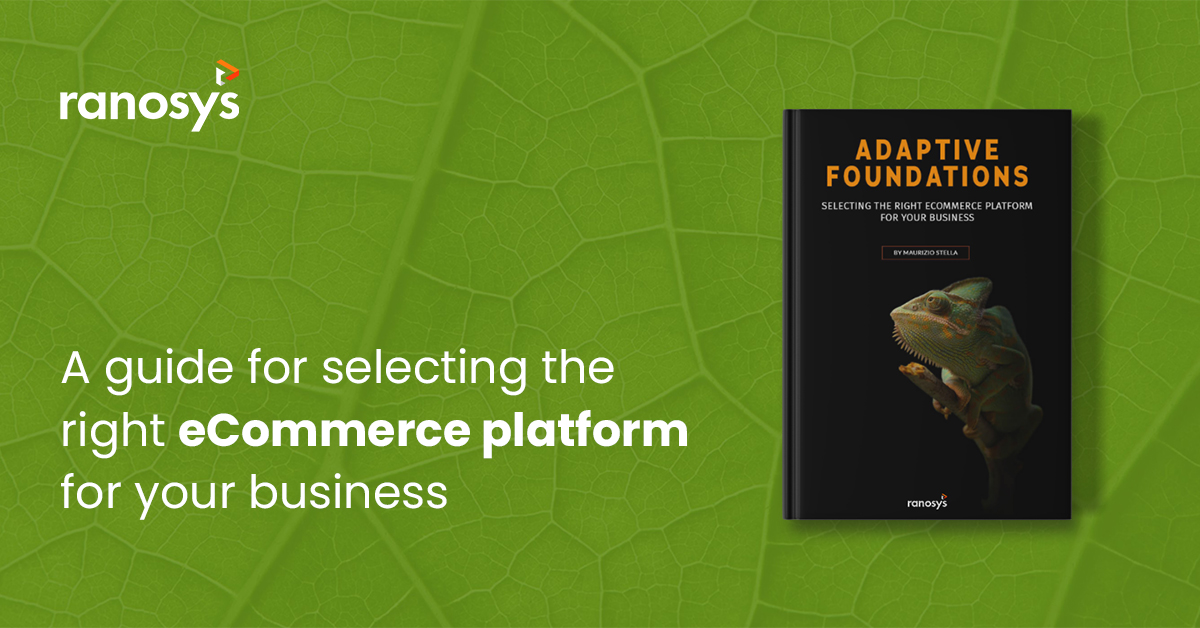Choosing an eCommerce platform requires strategic thinking and planning. Whatever eCommerce platform you choose will help lay the foundation and give shape to your online store. However, still, eCommerce platforms represent the part of the eCommerce solution that gives solidity, shape and integrity to the overall structure. Over time, it will be your eCommerce solution that has to change and adapt to the market dynamics and customer expectations. And this is only possible when your eCommerce platform at least delivers one thing: adaptive foundations.
“It’s not about having everything on one platform, it’s about facilitating the use of anything that will come.”
This ebook addresses three key points:
- Why should foundations be adaptive?
- How will adaptive foundations help the merchant achieve success?
- What makes foundations adaptive?
Alongside, you will learn about how an eCommerce solution is a sum of so many factors, other than eCommerce platform, such as culture, vision, digital maturity, and more. On completion, you can choose the most appropriate foundations for your business for your digital journey.
Platform VS solution: The difference
eCommerce Platforms and eCommerce Solutions are two very different things and should not at any point be confused.
An eCommerce platform is a software that facilitates or enables the selling of goods online. Conversely, it alone cannot support a buyer’s journey from start to end. For example, an eCommerce platform does not facilitate the payment of goods unless a payment gateway is integrated to it.
Put simply, an eCommerce platform requires the assistance of other tools and technologies to fully support a customer’s journey.
In comparison, an eCommerce solution is a comprehensive amalgamation of tools/technologies, processes, people, services, competencies, and data all working together like a well-oiled machine. Collectively, these attend to a merchant’s needs and fulfills customer expectations.
Therefore, to select the right eCommerce platform or to avoid choosing one that does not fulfill your goals in the long run, you need to consider several parameters other than just an eCommerce platform.
The formation of eCommerce suites
For an eCommerce platform, both merchants and market pose different requirements. While merchants are looking for simplicity and flexibility to pay for tools they use, markets require a well-integrated solution that offers them an omnichannel experience throughout. While eCommerce platforms have tried building too many features, they were easily outperformed by other third-party service providers that were more affordable and easy to use and integrate.
Today, eCommerce platforms aren’t the only tool merchants need to build online stores but one that lays a strong groundwork where they can plug in additional enhancements. Over time, as customer expectations change, eCommerce platforms/suites will come to include more powerful tools to stay competitive and relevant.
The Fall of Custom Built Solutions
When comparing eCommerce platforms and custom-built solutions, the latter seems to lose the lead for a few understandable reasons:
- Custom-built everything must be built from scratch, not a very cost-effective choice.
- With so many tools and technologies available in the market, merchants find it challenging to keep up. At the least, integrations must be developed either from scratch using APIs or via file exchange to implement a functionality/trend.
- With the rampant speed of change, a custom-built solution delays things for merchants, which means they can’t fulfill consumer expectations and even increases the overall choice of the solution.
- Since parts and portions of tools and systems are involved, the entire legal responsibility falls upon the merchant.
Things to consider when choosing an eCommerce platform
#1: SaaS, PaaS, On-Premises, and whatever else will come
SaaS (Suite-As-A-Service) and Open SaaS: SaaS, popularly termed as Suite-as-a-Service (SaaS) is a software developed by a service provider, wherein merchants gain access based on their licensing costs and specific credentials. Merchants can integrate other systems to it via plugins/extensions or via APIs. Customizations to the core, however, are limited with SaaS solutions. Examples of SaaS platforms include Salesforce Commerce Cloud, Shopify and BigCommerce.
PaaS ( Platform-as-a-service): Unlike SaaS, PaaS is a fully hosted solution, retaining the authority for the service provider to edit its core while allowing merchants to also be able to move it to their servers and infrastructure. Primarily, PaaS provides more freedom to merchants with respect to customizations. Adobe Commerce, formerly known as Magento, is an example of PaaS.
On-Premise: A Platform is provided for merchants to install and configure on their chosen infrastructure. Most PaaS platforms used to be on-premise up until SaaS became their biggest competitor.Examples include, SAP Hybris, IBM Websphere and WooCommerce.
#2: Using tech VS being tech
There are two groups of companies selling online:
- One that relies on technology and focuses on their brand, its mission, vision, and growth
- Other that builds an internal tech team and becomes an all-in-one company
“There is no right or wrong answer here. This is about you and how you like to do things. Merchants can thrive in both cases.”
However, as technology specialists, there are three main downsides of building an internal team and trying to manage both brand growth and technical competencies:
- Less inspiration from the outside world.
- Harder to retain good technical talents, because it’s not as exciting to always work on the same project.
- It can be significantly more expensive to build an internal team.
#3: Your Digital Commerce Maturity
Merchants should measure their internal capabilities through a self-assessment before arriving at any decision. This should be done in 3 distinct phases:
- Inside-out Assessment: During which you look at your business and self-assess your digital maturity.
- Outside-in Assessment: During which a third-party or your customers provide feedback to define how the world sees your business in terms of digital maturity.
- Outside-out Assessment: Measuring your business against industry best practices and not just your competitors.
#4: The dynamic eCommerce ecosystem
The eCommerce ecosystem is divided into four main areas :
- Clients: They pay for the evolution and leverage the power of tech.
- Platforms: They aggregate best practices that apply to at least 80% of their target audience.
- Third-party tech providers: They bridge the gaps between what a platform provides and the needs of 80% of their target audience.
- Agencies: They make the exchange information seamless and safe, while providing consultancy and training to merchants.
#5: Your goals
Before selecting a platform, you must mention your SMART (Specific, measurable, achievable, realistic & timely) goals. Setting goals is helpful to understand what digital maturity phases are and how your goals need to be considered. While there are different phases to goal-setting, our eBook, Adaptive Foundations explore more in detail about this.
#6: Your budget
Undeniably, budget plays a critical role during a platform selection process, however, as platform is only a part of the solution not the entire solution, merchants must explore total cost of ownership (TCO) instead.
#7: Your culture
It is imperative to choose a platform that aligns with your internal culture. Some eCommerce solutions might take months to come to fruition while others are done in 3-4 weeks. Therefore, consider your internal culture, project duration, collaboration requirements, hierarchical roles, and so on.
#8: Your current setup
In case of re-platforming, the most challenging is the data-migration phase. Primarily, data migration tools expect a vanilla setup on the other end. Any customization applied to your current solution may impact the future platform’s ability to deliver on the promise. Some platforms can be a bit restrictive; others even provide support for headless development, which means that the platform powers all the flows, processes, and UX frontend of the site is wholly detached from the platform and can be personalized.
#9: Your customers
Customers will likely never realize what platform you have implemented, but considering some of their needs will help you choose the right platform. You have to check whether features are natively-built in or are there additional modules or extensions that can be leveraged to improve the functionality. As B2B, B2C, and DTC customers have different needs, you must consider your target audience before choosing an eCommerce platform. Consider aspects like your global audience base, if you have physical stores that must also be integrated to this online solution for an omnichannel experience, and so on.
#10: Your Catalogue
Before choosing an eCommerce platform, you must check the providers’ catalogue management capabilities. Firstly you need to be clear on what kind of products there usually are: simple products or configurable products, then how many SKUs, variants, and updates of catalog. Some platforms are built to manage extensive and even multiple catalogues in multiple languages and currencies. Other platforms can manage products with hundreds of thousands of variants, but not all can do this natively.
Adaptive Foundations: Why does it matter?
The foundations should be solid and flexible in delivering a proper mix of reliability and scalability for an ever-evolving solution. The solution must be more dynamic to experiment with new tech, channels, etc. and must be extendable to touchpoints and devices across.
How adaptive foundations will help the merchant achieve success?
Merchants need to adapt not only customer needs but new platform features for experimental innovations. Investing constantly in the solution will gradually allow them to enter the “mature” or “leader” phases of digital maturity.
What makes foundations adaptive?
When selecting an eCommerce platform, some key points make them adaptive. These are:
- How many fast-growing clients are using the platform?
- Are the APIs well documented (ask other clients)?
- Does it come with a set of themes that can help speed up initial implementations?
Final Considerations
Adaptability is vital during a platform selection process. Merchants need to first work on the hard facts. Then, once platforms have been shortlisted, choose the one which is more aligned with change and evolution. Check the core features like currencies, languages, locations, warehouses, etc. If the platform has severe limitations on these core areas and extensions and modules provide partial solutions, a merchant needs to decide whether you should compromise.





